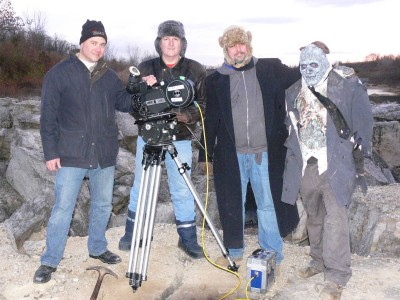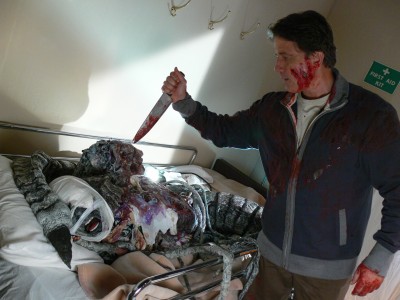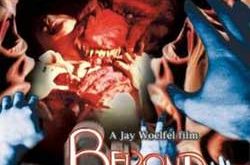 Exclusive HorrorNews.net Interview:
Exclusive HorrorNews.net Interview:
Jay Woelfel (Season of Darkness)
Where did the concept for Season of Darkness come from?
I saw the film THE BOSTON STRANGLER, which I still think is among the best serial killer films ever made. Then I read Gerald Frank’s book that it was based on and at one point Albert De Salvo/ The Strangler reads or hears about THE BIRDMAN OF ALCATRAZ and decides to try to make something of his life despite his crimes. I’ve never been able to find out if DeSalvo made that effort genuinely or not, as he was killed in prison, but the idea of if you really discovered you’d done something that horrible what would you or how could you somehow make up for that? Now the main character in SEASON OF DARKNESS isn’t a serial killer and I don’t want to give anything away here as his discovering what he is and what is going on is a mystery that propels the film, but you’ll see something of that personal responsibility problem that he has to face.
The overall idea is too follow someone who is insane and seeing the world through their insanity. Insanity can be kind of a rush like being really drunk. There can be a sort of amoral freedom and high from it and that’s part of the main Character, Dwight Stroud’s journey out of captivity, well played by Nick Baldasare. But what Stroud is also discovering is that some of what we/he sees is actually a peek into the supernatural horrors that sane people can’t see or dismiss as insanity. I guess the film is saying just because you see something that can’t be real and must be insane and therefore unreal, it’s just the opposite. After all, if the world is insane then only the sane people can’t understand it. On a more personal note I know someone who has had to spend time, not much thankfully, but spent time in what used to be called THE PSYCH WARD, now I believe they call such areas ADULT NEUROSCIENCE. So I’ve visited them there and had other experiences with them leading up to and after such “episodes” that makes the subject pretty subjective for me. Not on the supernatural side of things but tough enough even so.
 Are you inspired by any psychological thrillers?
Are you inspired by any psychological thrillers?
When I read that term I assume that means that “it’s all in his/her head.” That nothing much will really happens other than maybe some sweaty close-ups of actors faces. To me, it’s a code word for a boring thriller. But outside my negative gut reaction, to say movies/books where the psychology of the character(s) drives the plot, the thrills, the horror and fights with and or grows out of the people in the story, then yes indeed. I mean that should be the case in any good movie or story. Plot and character should be stuck together like glue one thing doesn’t happen without the other being effected. That’s what takes a cliché melodrama and elevates it to drama, deeper characters. Robert Bloch would be a particular influence on this film. There’s a moment in the film HOUSE THAT DRIPPED BLOOD in which a “crazy” patient is talking to his psychologist when the “imaginary” killer comes in and kills the disbelieving psychologist. There’s a similar, BLOCH inspired, moment in the first CANDYMAN film as well.
I do like and frequently include I guess you’d say mystery and or suspense elements to the films I’ve done. Basically I prefer films, even as a viewer, that I don’t know how they will end from the way they start, so I try to make that type of film as well. I like films where the audience is on the side of the main character(s) and you discover the horror and resolve the mystery just as they do. That’s a big element of SEASON OF DARKNESS in particular as where it ends up is a bit, or a lot, subversive when it’s all said and done.
Why did you choose to film in 35mm?
I had done two (GHOST LAKE & CLOSED FOR THE SEASON) of my previous three features on HD. The middle feature being LIVE EVIL which was shot on super 16mm and I had no interest in using that format ever again. HD and DIGITAL keeps getting better and of course is taking over everything from the cameras you shoot on to how you edit and project and store your final versions. But HD being so in demand, and still evolving every few weeks or months, means that it’s expensive to get the newest best cameras let along have multiple cameras, which I needed on this film to be able to have an FX unit to do the transformation type scenes.
Also as you might guess from the title there is a good amount of Darkness in this film and HD still has some issues there. Try having someone bleed red blood at night under blue lights and have it look like red blood under blue light on HD. Some of the very good film stocks now can see better at night, they see more they seen it more clearly—to keep things on non tech talk level. Film can still handle the extremes of bright and dark better than HD. Film in general handles skin colors better than HD as well. Now with all the time and all the money in the world what I’ve just said isn’t true but not many productions have all the time and money in the world so that’s part of the choice. Also if you’re doing one of those basically colorless desaturated-vaguely-cold-bluish-look movies then HD can handle that just fine.
But now there is a brief window, that may already be almost closed, where 35mm the standard for professional work since practically the dawn on film and that’s 100 plus years now, can in some ways be cheaper and better. For instance it’s actually cheaper now, and cleaner look-wise, to make a 35mm print from the camera negative, instead of digitizing the entire negative one frame at a time into computers then outputting it to a DI and then a DCP. A lot of tech talk and abbreviations, but that’s the world we live in there isn’t even time to spell out complete words anymore.
So with this film we had access to more 35mm cameras and also the opportunity for a pro level finish. Another factor is that the best HD cameras have now gotten fairly large, with 35mm you can still shoot on really small cameras when you need to and not kill the look of the image the way you do with lower end small HD cameras. Also, or maybe more importantly, we’re still at a point where people over 20 years old at least, grew up watching 35mm films, it has a feel, an atmosphere, you’d almost say retro feel, that works for this story. Notice too that we did virtually all the special effects in this film on set, not with CGI. So the whole 35mm thing hopefully gives it all a particular feel, not nostalgic, but a look that goes along with the supernatural quasi psychedelic horror world of the film.
Or let me say it this way watching this film I’d rather it feel like THE OMEN, or any HAMMER HORROR FILM than say, Paranormal Activity (fill in the numeral after it). Scott Spears the DP chose to shoot this film using a very subtle black defusion filter that gives a little steely tone and edge to it, if you used this same filter in HD you wouldn’t even be able to tell it’s there, for example.
Are you also hands-on creating some of the creatures and effects?
As much as possible…I would have liked to be there to shoot all the creature effects myself but the schedule didn’t allow for it. I did work with the effects guys, BRIAN SPEARS was the fx supervisor, a lot before shooting the film. He’s worked often with Larry Fessenden who’s a filmmaker I admire.
Brian actually was the first person hired and had twice as much pre production time as the rest of the film did. He knew about the film years before we even shot it and he made me promise after he read the script, that when I did it that he’d have the job, he and Pete Gerner were the main two guys doing the effects construction and execution. Part of what excited them, I think, was that they would be in charge of their own unit and have the time to do it right. So I saw designs in preproduction and story boards, and worked alone with them closely before and during production off and on set often.
The second unit DP who worked with them mostly was JOSE CARDENAS who had shot all of my previous film CLOSED FOR THE SEASON so it’s not like I didn’t know what I’d be getting or any of them didn’t know what we were after. We’d shoot the sequences with actors first unit, so I was there for that, then they’d have a full day after that to shoot all the specific effects stuff. There is however one big, massacre scene is the only way to describe it, that was all done first unit. And we even then did some pick up days, after the main production was over, to re-shoot or just focus on some fx shots.
 How long did it take to complete filming?
How long did it take to complete filming?
29 or 30 days. Remember that’s not counting that we had two units working at the same time part of that time so we’d get 2 days worth of work out of one day on some occasions. Any good film needs as much actual shooting time as you can give it.
Where did the filming take place?
In and around Columbus Ohio. That’s where I went to film school and where I did my first feature BEYOND DREAM’S DOOR. Fans of that film will recognize a few locations and lead actor NICK BALDASARE. The Cast and crew were a mix of Columbus, Los Angeles and the special effects guy drove in form New York City. We shot in the fall around Halloween so we got nice oppressive fall storm clouds and even some snow, looks great, not as much fun to work in as to see when it’s finished, but good for the story. We shot in locations that would be beyond our budget grasp in a place like LA or New York.
We shot in some real Indian caves and at the Columbus Art Museum both of which add a lot of atmosphere and production value and also a lot of night exteriors and in a cemetery which are really expensive to do elsewhere. We built sets as well as the mostly practical locations, but all in Ohio.
What was the most difficult aspect of making this movie? Making a movie that’s good is always the challenge. Anyone can make a movie but not anyone can make a good one and that’s a bunch of decisions, mistakes, or compromises every second of the way from start to finish. Speaking of finishing the post production took much longer than I expected. It was also far harder to get a local crew together for the film than it was to find local actors. The acting pool has grown in size and talent since I last made an Ohio movie. One problem was the local crew was a commercially oriented one. They liked and were used to short schedules and high pay. If they signed up for our feature they would make more than they would doing a commercial for a few days but the relative amount they’d be paid per hour was of course much lower. We were never able to crew up as fully as we’d planned there just weren’t enough able bodies. So we ended up with a few bodies who weren’t so able and we couldn’t’ fire because there was no one to replace them. We did get some newer crew people who had only worked on features—because Ohio does get in some big productions, like this summer’s THE AVENGERS for example. So these crew people helped make up for the crusty commercial/industrial crew types. It was a workable if delicate balancing act as a production.
But there was one crew member who had lived and worked in LA briefly who was used to telling people in Ohio how it was done in LA and getting away with it, but when he tried to pull that with Lawreen Yakkel(the producer) she said: “Jay and I make movies in LA all the time, not just for 6 months 2 years ago.” The weather, as I mentioned, got very cold. There was even snow in October! But it was the locals who seemed more shocked by this than us LA imports. Perhaps we knew if we put up with the cold for a few days we’d then be back in our beds with only a sheet to keep us warm, where people there saw it as the beginning of the end or something. The same crew member actually asked if we’d buy him a pair of boots. Really this isn’t like Valley Forge where you are trapped with no access to anything and the British are coming! I’m from Ohio originally and now I know it’s true, you can’t go home again, but you can try to shoot a movie there. All in all and like all productions the things you least expect are those that will swim up and try to bite your ass when you least expect it.
What would you consider your proudest moment of filming this movie?
Remember first the movie SEVEN, pride is one of the seven deadly sins. I don’t know I’d take it as far as John Doe. But I do believe pride is sort of a dangerous thing it just inflates your ego to the point that you can’t see beyond your delusions of grandeur and that makes your work suffer. I was proud to know, and have come back to my home town to help me make a film, the “stars” of the film RICHARD HATCH, TIM THOMERSON, and of course TIFFANY SHEPIS. I didn’t expect them being there to mean so much to me personally, I can’t even properly explain it. They are all very good in the film and get to do things their fans will hopefully be surprised by and enjoy.
 Do you have any cool or “scary” behind the scene stories while filming?
Do you have any cool or “scary” behind the scene stories while filming?
Richard Hatch had never shot or even been in a graveyard before at night. So he was, not scared but was decidedly nervous. I just said “See if you make enough movies with me you’ll get to do all kinds of new things.” I’ve shot in graveyards before at night and rather like doing so. I think the dead like company. I’ve found shooting in abandoned places share that feeling or wanting you there, of being rather pleasant places to be. My CLOSED FOR THE SEASON movie was mostly shot in an abandoned, and subsequently demolished, amusement park. That whole story is about that strange “warm” haunting feel you get. A feeling of being welcome in the place you are working. That film’s whole story is about that to a degree.
On this film though post production was perhaps the scary part. Post production took far too long in general—which was scary enough to me– but still would you think that two sound men would die and one actor who was almost in the movie die before the movie was finished? Seann Flynn who was half done with the sound mix was killed in a horrible accident. Then Charles Ballard who was my original choice to do the sound and, who had mixed a number of previous films for me, died suddenly as well. Also Corey Haim was on set with us, for reasons a clever fan can figure out with some googling. I could have had him play one of the guys in the massacre scene I mentioned. If I had this would now be his last film to get released. It would have also meant his last scene would involve a very violent death. Not so sure how I’d feel about that but it’d probably be a lot like Richard Hatch felt in that graveyard late one snowy night.
Closed for the Season. Season of Darkness. What Season is next?
I think I’m done with the word season. But Dark still needs a workout! I think the next one should start with the word Dark or Darkness, so the titles keep fitting together. I have a project that could be next called OUT OF THE SEA, which could maybe be called OUT OF DARK SEAS? Or DEATH FROM DARK SEAS? I do have a project that’s been in and out of pre production twice called THE DARK BETWEEN THE STARS, so that would fit. Who knows though? Maybe Shakespeare does when he said “A Rose by any other name would smell as sweet.”
Interview: Jay Woelfel (Season of Darkness)
 Horror News | HNN Official Site | Horror Movies,Trailers, Reviews
Horror News | HNN Official Site | Horror Movies,Trailers, Reviews



![Closed For The Season 2010[1]](https://horrornews.net/wp-content/uploads/2011/09/Closed-For-The-Season-20101-310x165.jpg)